Remove the air duct(A).
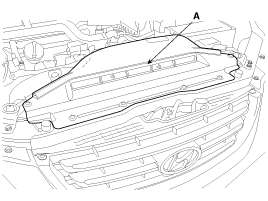
Use fender covers to avoid damaging painted surfaces.
To avoid damage, unplug the wiring connectors carefully while holding the connector portion.
Mark all wiring and hoses to avoid misconnection.
For release the fuel system pressure before remove the engine assembly, start the engine without fuel pump relay. And then turn off the ignition switch after engine stops.
Disconnect the battery nagative terminal from the battery.
Remove the air duct(A).

Remove the battery and the battey tray.
Recover refrigerant and remove the high & low pressure pipe. (Refer to HA group - air conditioner compressor)
Remove the air cleaner assembly.
Disconnect the breather hose (A).
Disconnect the ECM connectors (B).
Disconnect the AFS connector (C) and then remove the air cleaner assembly (D).
Tightening torque
7.8 ~ 9.8N.m (0.8 ~ 1.0kgf.m, 5.8 ~ 7.2lb-ft)
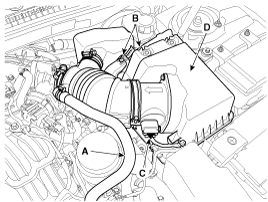
Remove the under cover(A).
Tightening torque
9.8 ~ 11.8N.m (1.0 ~ 1.2kgf.m, 7.2 ~ 8.7lb-ft)
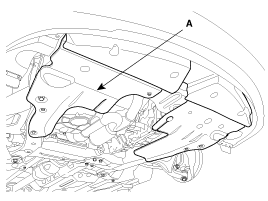
Drain the engine coolant.
Remove the radiator cap to speed draining.
Remove the radiator upper hose (A) and the lower hose(B).
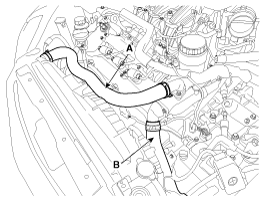
Remove the engine wiring connectors, the harness protetors ans mounting clamps.
RH front, rear oxygen sensor connectors (A)
Power steering oil pressure sensor connector (B)
VIS solenoid valve connector (C)
RH exhaust camshaft OCV connector (D)
RH injector connector (E)
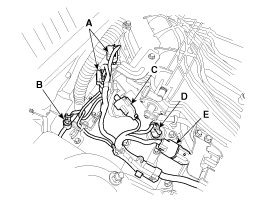
Condenser connector (A)
RH ignition coil connector (B)
Knock sensor connector (C)
LH/RH intake camshaft OCV connector (D)
LH exhaust camshaft OCV connector (E)
LH injector connectors (F)

LH ignition coil connectors (A)
LH exhaust CMPS connector (B)

LH front oxygen sensor connector (A)

Alternator connector (A) and the 'B' terminal cable (B).
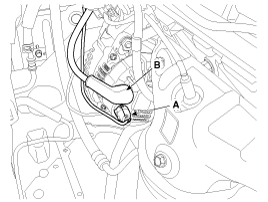
LH intake CMPS connector (A) and the oil pressure switch connector (B)

PCSV connector (A)
MAP sensor connector (B)
RH intake CMPS connector (C)
ETC connector (D)
OTS connector (E)

Knock sensor connector (B) and the RH exhaust CMPS connector (A)
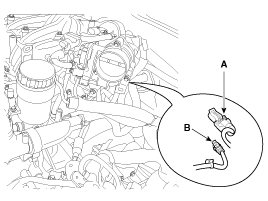
WTS & gauge unit connector (A).

LH rear oxygen sensor connector (A) and the CKPS connector (B)

Disconnect the transaxle wire harness connector and the transaxle control cable.
Disconnect the heater hoses (A), the brake booster vacuum hose (B) and the fuel hose (C).
Tightening torque :
9.8 ~ 11.8N.m (1.0 ~ 1.2kgf.m, 7.2 ~ 8.7lb-ft)
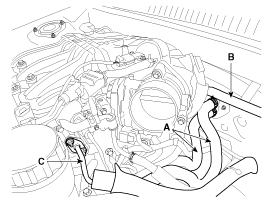
Remove the lower arm ball joint.
Remove the tie rod end ball joint.
Remove the stabilizer link.
After removing a split pin and nut from the steering bar tie rod, disconnect it.
Remove power steering return hose(A) and drain power steering oil.
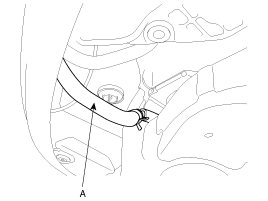
Remove steering u-joint mounting bolt. (Refer to ST group)
Remove front muffler (A).
Tightening torque : 39.2 ~ 58.8 N.m (4.0 ~ 6.0 kgf.m, 28.9 ~ 43.4 lb-ft)
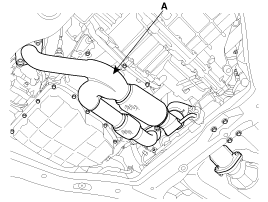
Support the sub frame (A) with a floor jack, and then remove the stay (B) and the sub frame mounting bolts.
Tightening torque :
Sub frame bolts and nuts: 137.3~156.9Nm (14.0~16.0kgf.m, 101.3~115.7lb-ft)
Stay bolts and nuts: 44.1 ~ 58.8 N.m (4.5 ~ 6.0 kgf.m, 32.5 ~ 43.4 lb-ft)


Check that all the cables, harness connector and hoses are disconnected from the engine and transaxle assembly.
Disconnet the ground cable(A) and then remove the engine mounting support bracket (B),
Tightening torque : 63.7 ~ 83.4N.m (6.5 ~ 8.5kgf.m, 47.0 ~ 61.5lb-ft)

Remove the transaxle mounting bracket(A).
Tightening torque : 63.7 ~ 83.4N.m (6.5 ~ 8.5kgf.m, 47.0 ~ 61.5lb-ft)
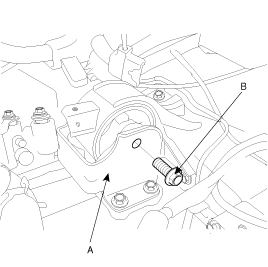
Remove the engine and transaxle assembly by lifting vehicle.
When removing the engine and transaxle assembly, be careful not to damage any surrounding parts or body components.
Installation is in the reverse order of removal.
Perform the following :
Adjust a shift cable.
Adjust a throttle cable.
Refill engine with engine oil.
Refill a transaxle with fluid.
Refill power steering fluid.
Refill a radiator and a reservoir tank with engine coolant.
Place a heater control knob on "HOT" position.
Clean battery posts and cable terminals and assemble.
Inspect for fuel leakage.
After assemble the fuel line, turn on the ignition switch (do not operate the starter) so that the fuel pump runs for approximately two seconds and fuel line pressurizes.
Repeat this operation two or three times, then check for fuel leakage at any point in the fuel line.
Bleed air from the cooling system.
Start engine and let it run until it warms up. (until the radiator fan operates 3 or 4 times.)
Turn Off the engine and let it cool down. Check the level in the radiator, add coolant if needed. This will allow trapped air to be removed from the cooling system.
Put radiator cap on tightly, then run the engine again and check for leaks.